Isabella Bradford's Blog, page 60
March 27, 2016
Atlanta's Historic Oakland Cemetery
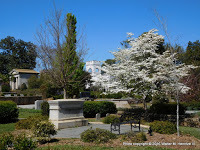 View of Bell Tower RidgeLoretta reports:
View of Bell Tower RidgeLoretta reports:The first time I visited, years ago, all I knew about Atlanta’s oldest public cemetery was, Margaret Mitchell was buried there. Then I knew nothing about the rural cemetery movement , only that this was a beautiful place.
On my most recent trip to Atlanta, I had the privilege of touring Oakland Cemetery with members of the Historic Oakland Foundation, as they planned their annual Halloween tour. My lips are sealed about the tour, but I promise a fascinating experience for those who join it next October.
 Still, Oakland is well worth a visit, no matter what.* In spring it’s simply glorious, with its flowering trees and shrubs and joyous birdsong. Though not originally planned as a rural cemetery, it is, like others I’ve visited, an oasis amid the city’s hubbub. It’s a park—a Certified Wildlife Habitat, in fact. This one, though, is filled with stories.
Still, Oakland is well worth a visit, no matter what.* In spring it’s simply glorious, with its flowering trees and shrubs and joyous birdsong. Though not originally planned as a rural cemetery, it is, like others I’ve visited, an oasis amid the city’s hubbub. It’s a park—a Certified Wildlife Habitat, in fact. This one, though, is filled with stories.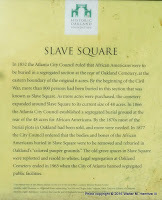
It’s the End of the Trail for Benjamin F. Perry, Jr. who designed the Buffalo Head nickel. Golfer Bobby Jones rests here, too. So does Maynard Jackson, Atlanta’s first African-American mayor, whose grave’s placement “would symbolize the final breaking of the color line within Oakland’s Original Six Acres.”
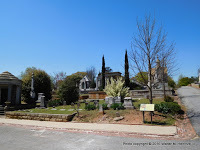 Slave SquareYes, the cemetery was segregated, and yes, the Confederacy looms large here—the Civil War and segregation are part of US. history. But here, too, in the Rawson mausoleum, are buried Julian** and Julia Harris, who owned the Columbus Enquirer-Sun, a paper that won the 1926 Pulitzer Prize for “the service which it rendered in its brave and energetic fight against the Ku Klux Klan; against the enactment of a law barring the teaching of evolution; against dishonest and incompetent public officials and for justice to the Negro and against lynching.”
Slave SquareYes, the cemetery was segregated, and yes, the Confederacy looms large here—the Civil War and segregation are part of US. history. But here, too, in the Rawson mausoleum, are buried Julian** and Julia Harris, who owned the Columbus Enquirer-Sun, a paper that won the 1926 Pulitzer Prize for “the service which it rendered in its brave and energetic fight against the Ku Klux Klan; against the enactment of a law barring the teaching of evolution; against dishonest and incompetent public officials and for justice to the Negro and against lynching.”Along with politics and war are human stories, many told briefly but poignantly in epitaphs, as well as art, from grand monuments and mausoleums with beautiful stained glass to small, delicately carved stone markers.
All quotations are from Ren and Helen Davis’s Atlanta’s Oakland Cemetery: An Illustrated History and Guide, a handsomely illustrated book offering exactly what the title promises: a detailed history as well as guide to the cemetery’s several “neighborhoods” (with maps), tales of those buried therein as well as that of the cemetery’s restoration.
*There are guided walking tours year round as well as special tours.
**Son of Joel Chandler Harris.
Published on March 27, 2016 21:30
March 26, 2016
Breakfast Links: Week of March 21, 2016
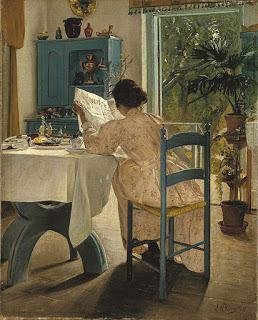 Breakfast Links are served - our weekly round-up of fav links to other web sites, articles, blogs, and images via Twitter.
Breakfast Links are served - our weekly round-up of fav links to other web sites, articles, blogs, and images via Twitter.• Artist seeks to revive the lost craft of painted Tudor wall coverings .
• Never returning to normality : zoot suits, drape jackets, and bondage trousers.
• More than a musical instrument: a portable Irish harp , 1819.
• From fashion accessory to feather duster: the history of the ostrich feather trade in London.
• Followed by: fashion, feathers, and animal rights .
• Dracula and the Victorian politics of blood.
• Image: Birmingham's Victorian " Temple of Relief " is surprisingly elegant for a public urinal.
• Florence Nightingale saved lives with statistics and made data beautiful.
• French customs and manners as observed by an 18thc Scotsman.
• The unknown Roman girl buried beneath a London landmark.
• The global connections of 18thc Charleston , SC.
• Psychologists have studied writer's block - and they know how to beat it.
• Image: A luxurious gold box for storing hats or headdresses from 15thc Florence.
• A plea on behalf of immigrants, most likely written in Shakespeare's hand .
• An international incident in 1839: an unsigned treaty and a slave ship from Duxbury, MA.
• Here be dragons - and battleships . In the middle of Manhattan, 1917.
• Touching the past: why history is important.
• Seven strange facts about early American funerals .
• Image: Spinning op art mosaic floor with Medusa at the center, from 115-150AD.
• Fighting in plain sight: women soldiers of the American Civil War.
• Would you buy a used car from William Shakespeare ? How about mustard?
• Picking locks and foreign plots: ciphers in British Library manuscripts.
• Just for fun: Quiz to determine what your profession would have been in Victorian England.
Hungry for more? Follow us on Twitter @2nerdyhistgirls for fresh updates daily.
Above: At Breakfast by Laurits Andersen Ring. Private collection.
Published on March 26, 2016 14:00
March 24, 2016
Friday Video: The Belle Époque—A Beautiful Life Once Upon a Time
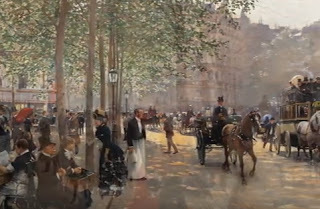 Loretta reports:
Loretta reports:Many of us are aware that WWI was the end of an era. Life changed everywhere, and it was, among so many other things, the beginning of the end of the great aristocratic houses with their armies of servants. While the houses remained, at least for a time, the way of life was gone, as were millions of young men.
This beautiful video uses paintings to show something of what was lost and why the era has been called the Belle Époque. But let’s remember that Mark Twain called it the Gilded Age, referring to surface beauty. Like other eras, it had a dark side.
For now, though, let’s focus on the beauty of these paintings, so seamlessly brought together in a panorama.
You can see the individual paintings here .
And here you’ll find, along with the video, more pictures as well as a summary.
Readers who receive our blog via email might see a rectangle, square, or nothing where the video ought to be. To watch the video, please click on the title to this post.
Published on March 24, 2016 21:30
March 23, 2016
Samuel Pepys Checks His Smartphone...er, Watch, 1665
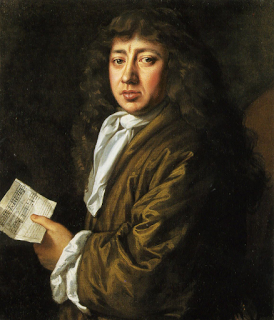 Isabella reporting,
Isabella reporting,Recently I shared an 18thc painting of several fashionable folk consulting a pocket-watch with much the same intensity that people (fashionable and otherwise) stare at their iPhones and Androids. Turns out that this fascination with the newest technology is even older, and English diarist, administrator, and politician Samuel Pepys (1633-1703), left, was equally addicted in the 1660s.
Here's a quote from his diary from May, 1665, discussing his watch:
"The the 'Change [the shopping mall of Restoration London] and thence to my watchmaker, where he has put [my watch] in order, and a good and brave piece it is, and he tells me worth £14, which is greater. . . than I valued it....So home and late at my office. But, Lord! to see how much of my old folly and childishnesse hangs upon me still that I cannot forbear carrying my watch in my hand in the coach all this afternoon, and seeing what o'clock it is one hundred times, and am apt to think with myself, how could I be so long without one; though I remember since, I had one, and found it a trouble, and resolved to carry one no more about me while I lived."
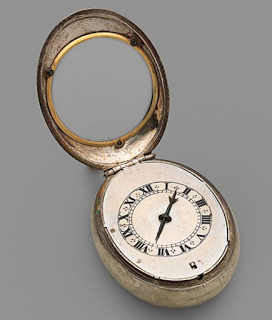
So even though all that Pepys's watch could to was tell the hour, he still couldn't help but check it repeatedly - and ostentatiously - throughout the day in a very smartphone manner. Unlike the ubiquitous smartphone, however, a watch was still a gentleman's costly status-piece, something that very few ordinary Englishmen would have possessed at the time. Pepys proudly states that his watchman valued his watch at £14. To put this in perspective, the average English laborer in 1670 was earning approximately £13 a year.
It's impossible to know exactly what Pepys' watch looked like, but it was probably similar to the watch shown here, right. Made in London about 1640 by master watchmaker Edward East, it features outer and inner cases of silver and a movement of silver, steel, and gilded brass, with an elegant openwork floral design, lower left.
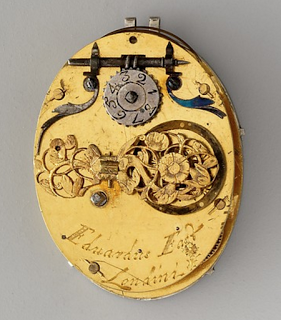
Note that the watch has only a single hand, for marking the hour. The second, minute hand didn't come into use until later in the 17thc, when the accuracy of watches had increased sufficiently to merit it. This watch could have run as long as sixteen hours from a single winding, although in the course of that time, it could also be as much as several hours wrong. But for its day, it was a marvel. Just ask Samuel Pepys.
Top left: "Samuel Pepys" by J. Hayls, 1666, National Portrait Gallery, London.
Lower right: Watch, made by Edward East, c1640, London. Metropolitan Museum of Art.
Published on March 23, 2016 21:00
March 21, 2016
From the Archives: King William III's Private Place
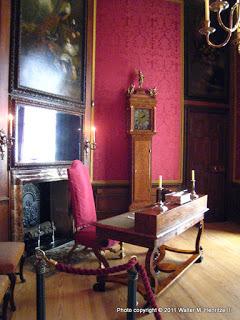 Loretta reports:
Loretta reports:State apartments are all very well, and I can be easily awestruck by, say, a magnificent painted ceiling, or candle stands that tower over my head.
But the most fun for me in touring a historic site is looking into the less public spaces: kitchens, for instance. Wine cellars. Bathrooms.
Previously we looked into Queen Caroline’s (Caroline of Ansbach 1683-1737) bathroom at Hampton Court Palace .
Nowhere in my perambulations, however, did I come upon the King’s bathroom. I did find his lavatory, though.
King William III (1650–1702) was not an extrovert. He liked to be alone or with small groups of friends. One of the places where he could have some privacy was what’s called the King’s Closet. Here he’d meet with the privileged few and work at his modest-looking walnut desk. His long-case clock nearby needs to be wound only once a year—highly advanced technology for the time.
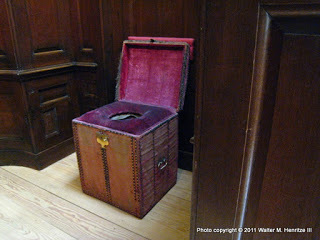 And in this private area, not far away, and in plain sight between the jib doors* is King William's own actual close stool. According to the brochure, “the Groom of the Stool was a senior courtier who not only ran the Bedchamber department but also had to personally attend the king on his ‘stool.’”
And in this private area, not far away, and in plain sight between the jib doors* is King William's own actual close stool. According to the brochure, “the Groom of the Stool was a senior courtier who not only ran the Bedchamber department but also had to personally attend the king on his ‘stool.’”I leave you to surmise what attendance entailed.
*"In Architecture, a door so constructed that it stands flush with the adjoining face of the wall on both sides, and without dressings or architraves. Thus it appears to form part of the wall, the intention of a jib door being simply to disguise the aperture." — A Dictionary of Science, Literature, & Art, 1875
Published on March 21, 2016 21:30
March 20, 2016
"Philadelphia in Style": A Century of Fashion
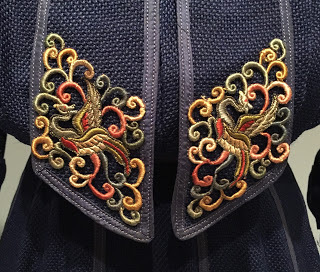 Isabella reporting,
Isabella reporting,As anyone who reads this blog regularly knows by now , there are few things I enjoy more than an exhibition of historic clothing. Last week I attended the preview of a splendid one: Philadelphia in Style: A Century of Fashion from the Robert and Penny Fox Historic Costume Collection, Drexel University. The exhibition is now on display at the James A. Michener Art Museum in Doylestown, PA, not far from Philadelphia, and what a pleasure it is.
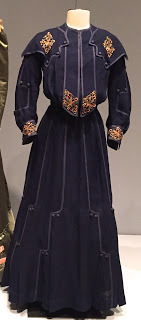
I saw a selection of pieces from the Fox Collection on display last year, but their holdings are so vast (over 14,000 pieces) that there aren't any duplicates this time around. The focus of this show is Philadelphia as center of style, and features clothing and accessories made, worn, or sold by Philadelphia women from 1896-1994. Unlike many costume exhibitions, the clothes are not locked away in Plexiglas boxes, making it easy to see (and photograph) the details of stitch, lines, and embellishments. I also appreciated that, while the clothes did belong to an elite group of customers, these women also came in a variety of heights, sizes, and shapes. These aren't all minuscule model-sized garments, and they reflect their wearers' bodies (and supporting undergarments) as much as their tastes.
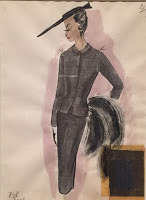
In addition to some truly exception clothes made by some of the biggest names in modern fashion history - Dior, Chanel, Halston, Callot Soeurs, Gallanos, Oscar de la Renta, Adrian – the exhibition also includes a selection of fashion drawings from the 1920s-1950s. These stylish sketches, (like the one middle left) some with fabric swatches attached, helped wealthy customers decide what to order from designers in those days before everyone had an iPhone aimed at the runway.
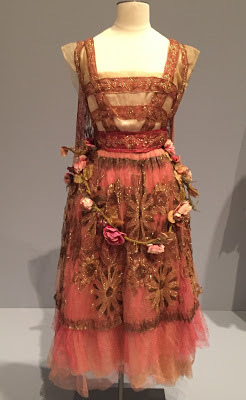 As difficult as it is for me to choose favorites, here are two of the dresses that I liked the most. The navy blue day dress, above left and right, was part of a Philadelphia bride's trousseau in 1903. The fabric is "homespun" (an evocative, romantic term by then, not a literal one) wool, but a very light-weight wool, woven in an open weave, that would have made it practical for summer travel or promenades. But it's not entirely sensible: the contrasting trim adds stylish emphasis to the dress's lines, and the embroidered Chinese-inspired applique is bright and eye-catching. The young bride who wore this dress would have begun her married life quite fashionably.
As difficult as it is for me to choose favorites, here are two of the dresses that I liked the most. The navy blue day dress, above left and right, was part of a Philadelphia bride's trousseau in 1903. The fabric is "homespun" (an evocative, romantic term by then, not a literal one) wool, but a very light-weight wool, woven in an open weave, that would have made it practical for summer travel or promenades. But it's not entirely sensible: the contrasting trim adds stylish emphasis to the dress's lines, and the embroidered Chinese-inspired applique is bright and eye-catching. The young bride who wore this dress would have begun her married life quite fashionably.Not even twenty years separate the navy dress from my second favorite, but fashion changed dramatically in that time. Gone is the ground-skimming hem and corset-defined shape The dress, right, is a 1916 evening dress by the famous Parisian design house of Callot Soeurs, and it's as insubstantial as a summer breeze.
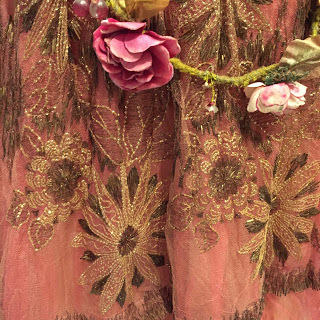
Made of silk satin and net, and trimmed with metallic embroidery, velvet trim, and millinery flowers, the colors are still fresh and vibrant. There are two long streamers from the back shoulders, and those, combined with the airy full skirt, must have been made for the latest foxtrot. But although the colors are still fresh and bright - I'd bet there are plenty of high school girls today who'd love to wear this dress to their proms - the dress itself is so fragile that this will likely be its one and only time on display. Like Cinderella herself, this dress will have this final time beneath the lights to sparkle, and then back it will go into careful storage.
Philadelphia in Style will be on view through June 26, 2016. See the exhibition web site for more information and directions. For more information about the Fox Historic Costume Collection, see here .
Top dress: Day Dress, blue homespun wool, 1903, American.
Middle illustration: Fashion Illustrations for Nan Duskin, watercolor, gouache, ink on paper, c1954, American.
Lower dress: Evening Dress, by Callot Soeurs, silk satin, net, velvet, millinery flowers, with glass and metallic embroidery, c1916-1917, France.
All pieces from the Fox Historic Costume Collection, Drexel University.
All photographs ©2016 Susan Holloway Scott.
Published on March 20, 2016 18:02
March 19, 2016
Breakfast Links: Week of March 14, 2015
 Breakfast Links are served - our weekly round-up of fav links to other web sites, articles, blogs, and images via Twitter.
Breakfast Links are served - our weekly round-up of fav links to other web sites, articles, blogs, and images via Twitter.• Mark my words: the subversive history of women using thread as ink.
• The 1871 cat show at the Crystal Palace.
• The best fashions of the 1940s through the pages of Life magazine.
• Image: In 1910 the National Association OPPOSED to Suffrage published this pamphlet outlining their opposition.
• How to find love in the 19thc: valentine writers and flirtation cards.
• How female computers mapped the universe and brought America to the moon.
• How patriot Ethan Allen got married to a Loyalist widow.
• Image: Recreation of Helen of Troy's makeup based on 13th BC Mycenaean plaster head.
• The oldest street scene photographs of New York City.
• Fanny Eaton , the black Pre-Raphaelite muse that art history forgot.
• Mansfield Park at two hundred: in defense of Fanny Price.
• Very rare stockings for a suffragette, embroidered with "Votes for Women."
• Debunking the myth of Scottish slaves .
• The laptops that powered the American Revolution.
• How a word's meaning changes: what could be nicer than nice ?
• Image: A book of erotic subjects , owned by George IV.
• Flora MacDonald : Jacobite or not?
• In the steps of 19thc knitting designer Jane Gaugain .
• The 1830 food riots in Limerick.
• R.K. Rowling interprets the historical tragedy of the Salem Witch Trials as...something else.
• Petticoats , busk boards, and pink lightning.
• Online exhibition of objects related to women during World War One .
• Image: Kensington Oval suffragettes , 1908.
• Two survivors linked to St. Alban, Wood Street: an old library book and an lonely church tower.
• Psychogeographers' landmark London Stone goes on display at last.
• Remarkable 15thc house and shop for sale in France - but it's a serious handyman's special.
• Utopia : nine of the most miserable attempts to create idealized societies.
• Just for fun: Mr. Darcy's shirt is coming to America, and no, you can't try it on.
Hungry for more? Follow us on Twitter @2nerdyhistgirls for fresh updates daily.
Above: At Breakfast by Laurits Andersen Ring. Private collection.
Published on March 19, 2016 14:00
March 17, 2016
Author Event in Florida
 Loretta reports:
Loretta reports:As many of our readers are aware, my real job is writing historical romance. As they are probably also aware, I don’t do many personal appearances. This is not because I don’t like meeting my readers. On the contrary, it’s way too much fun, and the temptation is to keep going here there and everywhere to meet them... and then fail to finish the book on time.
But this time my publisher made an offer beyond my temptation-resisting abilities: a chance to join Julia Quinn, Eloisa James, and Caroline Linden for an author event and book signing.
The bonus is, it’s in Florida, where I’ve been fortunate to spend the worst of the last few winters. All we have to do is not get eaten by alligators on the drive from the Gulf Coast to the Atlantic side.
 If you’re in the vicinity of Vero Beach, please stop by and say Hi.
If you’re in the vicinity of Vero Beach, please stop by and say Hi.WHEN:
Sunday 20 March
3PM-4:30PM
WHERE:
Vero Beach Book Center
325 Miracle Mile
Vero Beach FL 32960
Published on March 17, 2016 21:30
March 16, 2016
Fashionable Bookcase for March 1814
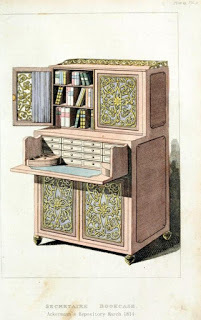 Secretaire Bookcase 1814
Loretta reports:
Secretaire Bookcase 1814
Loretta reports:Morgan & Sanders, of Nos. 16 & 17 Catherine Street, Strand, London, made and sold patent furniture that was often featured in Ackermann’s Repository. The globe desk I showed last month is an example.
Readers weighed in about the practicality as well as aesthetics of the item, which made me acutely conscious of the distance between the image and the actuality. This gap is clear when I show fashion plates. Rather like fashion sketches today, they’re stylized images, which often make clothing seem stiff and bizarre.
I think the furniture suffers worse in the illustrations. In both cases, I assume this happens partly because these kinds of engravings did not allow the artist the flexibility that paint did, but also because artists lacked the necessary skills and/or time. While Ackermann’s was an expensive magazine, the illustrations are not all of the same quality, and furniture seems to suffer worst.
In any case, I invite you to compare the magazine illustration with a version of one of these globe desks—this time not literally a globe, but global in form— as presented on the site 1stdibs . While this object may not appear any more comfortable a place to write, it doesn’t look as much like a strange object from outer space, and I think we can understand a little better why the Princess Augusta would buy it.
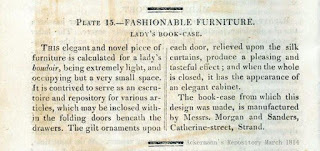 Bookcase description
Bookcase description
In the same spirit, I offer for your contemplation Morgan & Sanders’s “Secretaire Bookcase.” While I couldn’t find a version of the piece online, I did find some similar objects for compare and contrast exercise, here & here .
Clicking on the image will enlarge it. Clicking on the caption will take you to the source, where you can learn more and enlarge images as needed.
Published on March 16, 2016 21:30
March 15, 2016
Intrepid Women: Actress Sarah Siddons, 1755-1831
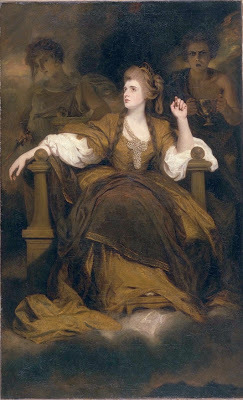 Isabella reporting,
Isabella reporting,In my new book, A RECKLESS DESIRE , my humbly born heroine Lucia di Rossi is determined to become an actress, and the hero Rivers is equally determined to guide her to dramatic success. For her debut in London, Lucia appears as Ophelia in a production of Shakespeare's Hamlet, a role that Rivers chooses as fitting her gift for tragedy.
The inspiration for much of Lucia's budding career comes from the most famous dramatic actress of the Georgian era, the legendary Sarah Kemble Siddons (1755-1831.) Although she was born into a theatrical family, Sarah's parents wished better for her than to be an actress, and also wished to remove her from the handsome but empty-headed leading man in the family troupe. They sent sixteen-year-old Sarah to Warwickshire, far from her sweetheart, where they hoped she would learn to become a lady's maid in a country house.
But Sarah forgot neither William Siddons nor acting, and entertained her fellow servants with dramatic readings in the servants' hall and before her master's guests. Finally her parents relented, and at eighteen, she married Siddons, and with him joined a provincial acting company. Word of her success there reached the famous London actor and producer David Garrick, who gave her her first role at Drury Lane in 1775.
It was a disaster. The critics were not kind, and she herself said that "she was banished from Drury Lane as a worthless candidate for fame and fortune."
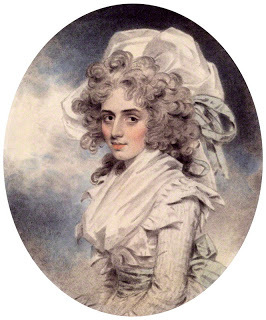
But the twenty-year-old Sarah refused to be discouraged. She returned to playing lesser theaters to hone her craft and mature into the tragic roles that would become her specialty, and to bear the first of her seven children. When she returned to Drury Lane in 1782, her performance was a triumph, and she never looked back.
While most successful Georgian actresses were graced with conventional beauty (some things never change), Sarah's appearance was more striking than pretty. She was tall, with flashing dark eyes, a prominent profile, and an intensity that mesmerized audiences. She specialized in playing powerful roles of tragic women, and made Lady Macbeth her own. She fascinated artists as well as playgoers, and she sat for all the major portrait painters of the day - Sir Joshua Reynolds, Thomas Gainsborough, Gilbert Stuart, John Downman, George Romney, and Thomas Lawrence - who all attempted to capture her brilliance.
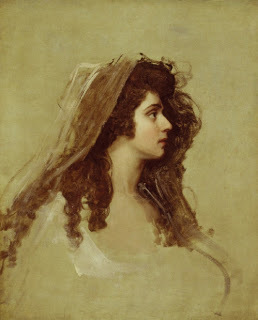 Sarah was remarkably dedicated to her career. Part of this was from necessity - she was the main support of her large family - and part was her own drive to perform. She continued to appear on stage throughout all of her pregnancies, usually up until a few weeks before giving birth. As her children grew, they were incorporated into her performances when her role called for her to play mothers. The audiences loved her all the more for it.
Sarah was remarkably dedicated to her career. Part of this was from necessity - she was the main support of her large family - and part was her own drive to perform. She continued to appear on stage throughout all of her pregnancies, usually up until a few weeks before giving birth. As her children grew, they were incorporated into her performances when her role called for her to play mothers. The audiences loved her all the more for it.Sarah formally retired from the theatre in 1812 after a career that stretched forty years. As writer and critic William Hazlitt noted, "passion emanated from her breast as from a shrine. She was tragedy personified."
Upper left: Sarah Siddons as the Tragic Muse by Sir Joshua Reynolds, 1784, Huntington Art Gallery.
Right: Sarah Siddons by John Downman, 1787, National Portrait Gallery.
Lower left: Mrs. Sarah Siddons by George Romney, c1785, private collection.
Published on March 15, 2016 18:55



